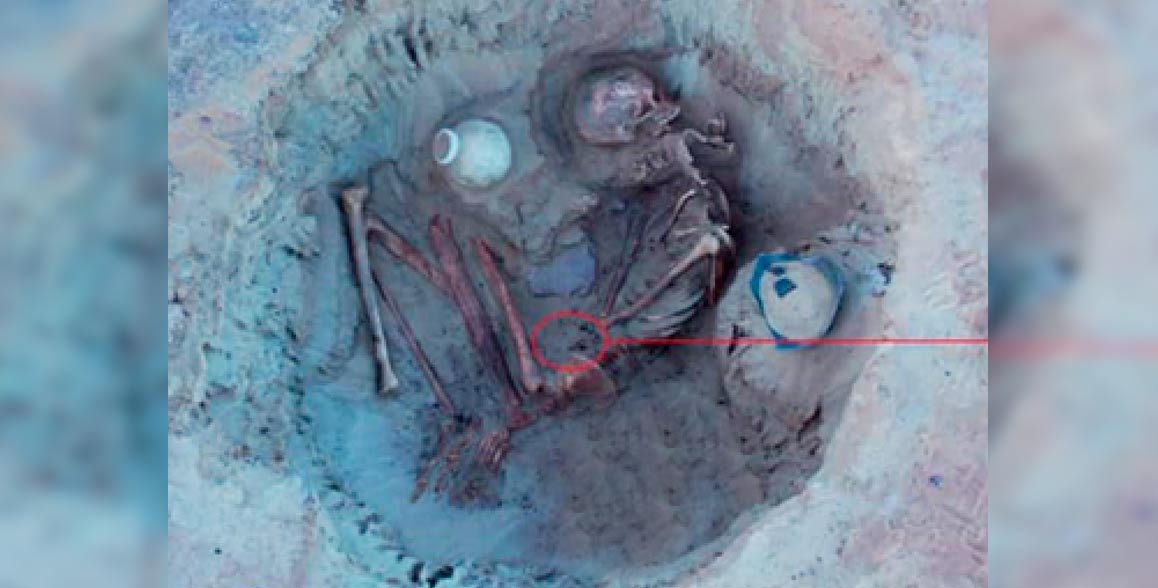A Mother, With Her Unborn Child Inside Her Womb, Surface in Egypt After 3,500 Years
Egypt’s Supreme Council of Antiquities have announced that archaeologists have uncovered in Aswan, Egypt, the skeletal remains of a woman who died towards the end of her pregnancy, still holding the fetus of her child inside her.
The remains of the woman, about 25-years-old, were discovered during a joint Italian-American archaeological project investigating a graveyard at the famous double temple, Kom Ombo, about 30 miles north of the southern city of Aswan, east of the River Nile. Earlier this year, archaeologists exploring beneath the temples found two sets of rooms, built in honor of two gods. They discovered painted tablets revealing new geological data pertaining to Horemheb, as featured in an Ancient Origins news article written by myself.
Discovery Hailed as “Extremely Rare”
The Supreme Council’s preliminary examinations found that the woman’s pelvis “had suffered a fracture that ultimately killed her when improperly treated,” according to a report on Newsweek. The way in which the fetus was positioned within the woman’s body suggested to archaeologists that she would have “given birth relatively soon if she hadn’t died.”
Professor Sandra Wheeler, a bioarchaeologist and professor at the University of Central Florida, told National Geographic “The discovery of a fetus still inside a woman from this period is extremely rare,” she added, “This reinforces the idea that childbirth was precarious and that maternal mortality was something people faced all the time.” Wheeler warns that “without the presence of soft tissues, it’s impossible to determine the cause of this woman’s death with certainty.”
The scientists press release of their discovery noted that “the mother’s pelvis was misaligned” which could be “a sign of trauma or malnutrition during the woman’s critical development years.” These clues, Wheeler says, “tell us about [women’s] lives and their childhoods.”

The remains of the pregnant woman and a close of the fetus within her pelvis. Credit: Ministry of Antiquities
Woman was Ready to Give Birth
Nigel Hetherington is an Egypt-based archaeologist and heritage consultant who promotes the work of fellow archaeologists through the organization Past Preservers, called the find “pretty unique.” He told MNN "The fetus had settled into the head-down position,” suggesting the woman may have died during childbirth. “Foetuses are repeatedly found in burials,” he explains, and, “We know that Egyptians did mummify foetuses... for very high-status people. They would try to take the babies with them into the afterlife. “There's something very poignant and quite sweet about it, but also very sad” he added.
- Tiny, 2,300-Year-Old Egyptian Mummy Believed to be a Hawk is Actually a Human Fetus
- A 7,700-Year-Old Case of Death During Childbirth in Siberia
- The Evolution of Human Birth: An Incredible Story a Million Years in the Making

A mummified fetus from ancient Egypt ( Maidstone Museum)
According to a press release from Egypt's Ministry of Antiquities, her skeleton was “resting in a contracted position, her head wrapped in a leather shroud. The grave also held two pottery vessels - an artfully made, but well-worn jar and a fine bowl with a red polished surface and black interior.” Inside the tomb the scientists also found “beads made from the shells of ostrich eggs, as well as pottery and jars in the tomb thought to date back some 3,500 years,” the researchers told reporters at National Geographic.
Mostafa Waziri, Secretary-General of the Supreme Council of Antiquities said on Facebook that “The tomb was found in a cemetery used by people traveling through the deserts to the south of Egypt said. It is thought to date from 1750-1550 BC.” Egypt’s New Kingdom emerged around 1550 BC bringing prosperity after 100 years of political and social chaos during the Second Intermediate Period.
A Window into Ancient Childbirth
An article on Forbes says that this discovery provides archaeologists “with a window onto pregnancy and childbirth in the past.” More than half of the graves in the Kom Ombo cemetery have been excavated and fully recorded by Gerda Henkel Foundation, the Italian Ministry of Foreign Affairs, the University of Bologna, and the Egyptian Ministry of Antiquities. The archaeologists concluded that “Additional work by AKAP will hopefully reveal more about a relatively unknown time period in Egyptian history and about the daily lives and deaths that occurred.”
Top image: The remains of the Egyptian woman with her unborn child. Credit: Ministry of Antiquities
By Ashley Cowie



















